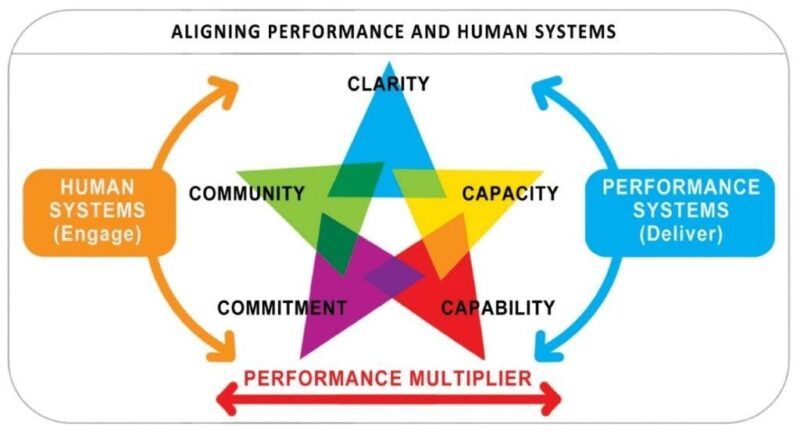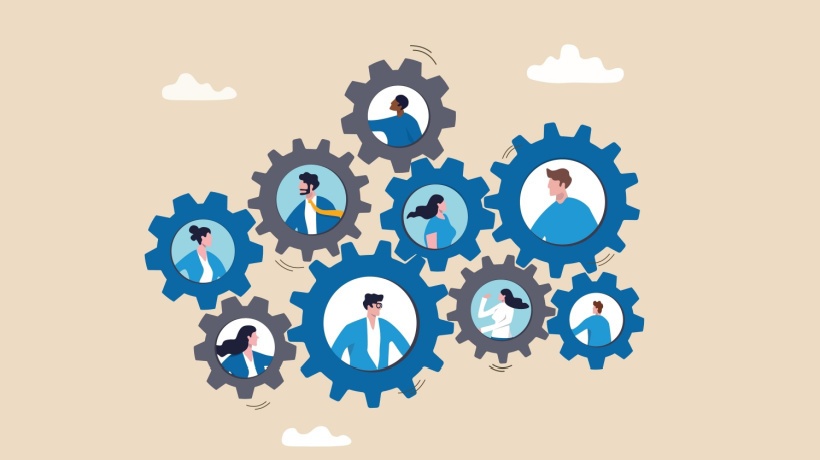Repositioning The Role Of Organization Development
Clarity of purpose and the clear expression of an organization’s intent to solve a defined problem for their identified beneficiaries enables leadership to develop a confident strategy to deliver this purpose. The strategy developed by leadership gives form to the design and nature of the organization’s Performance and Human Systems, illustrated in the diagram below.

Organization Development
Organization development is about the science and art of developing the leadership capability to achieve and maintain the optimum performance multiplier. On the Performance Systems side it is about the science of smart addition and even smarter subtraction. And, on the Human Systems side it is about the art of wise investment and the even wiser persuasion for disinvestment. The relevance of this will become apparent during the ensuing discussion, especially around implementation.
In designing and refining Performance Systems the key mindset question is
How do we change our ways of doing things so that our capital investment in equipment, systems, and processes allows our people to contribute to their full potential and be worth every cent of what we pay them?
Designing Performance Systems with this mindset and making the required operational choices enables the dialogue that is the lifeblood of the Human Systems. This congruence starts with offering the organization's Community of people worthy and worthwhile work and influence over things that matter to them.
Performance Systems
The distinction between using the term performance, versus operating or operational systems, is important. The subtle difference is in the intent to empower employees to take ownership of operational systems and to continually evolve them as Performance Systems that optimize each person and each team’s contribution.
Performing (verb) is a dynamic, intentional human activity to use one’s capacity and capability to achieve the best possible outcome. It implies that the locus of control is with the person performing to work to leverage their resources and capability to achieve optimum success. It requires that for their performance to be sustainable, they need to be directly involved in iterating continuous improvements and making any required changes to remain relevant. Operating (verb), on the other hand, implies a more passive approach to using something provided, as instructed by the provider (or operating manual or instructor) to achieve a desired outcome.
From a leadership perspective the first is about leading ownership of investment in performance and the second about managing outcomes of investments in operations, that is human resources and the tools they are given to do their jobs. It is a subtle difference but the consequences that emerge are important. Also, this distinction underpins a mindset difference between a “command and control” (even if it is benevolent) and a collaborative, servant-leadership approach to leading. It then further underpins the thinking behind developing, implementing, and evolving the key Performance System dimensions of organizational Capacity and Capability and their constructs.
Capacity is about having the appropriate means (resources and Performance Systems) to do what needs to be done, through the operational plan, to deliver strategy. Human beings populate the organization structures and work with the resources, systems, processes, and tools provided to deliver the operational plan to fulfil the organization’s purpose. Designing and investing in Capacity requirements is then ultimately an investment in the people who will leverage and iterate that Capacity to fulfil the organization’s purpose.
The differentiating questions to leaders are then “have we designed and invested in Capacity (as a key dimension of our Performance System) to enable our people to leverage their optimum potential to be productive and be worth every cent of our generous investment in them?” versus “are we squeezing the most out of our Capacity investment?” The latter mindset often prevails because minimizing costs is profitable. However, the former mindset of maximizing contribution is also profitable. The former requires a different system supported by the appropriate disciplined choices and a growth mindset. The former is about intentional choices to avoid a vicious cycle of cost-cutting to be profitable and to intentionally evoke a virtuous cycle of investing in people to optimize results (as defined by customer metrics, people metrics, and Performance System metrics) to achieve profitability.
A major aspect of the mindset shift to an investment in Performance Systems to support and leverage the contribution of the people invested in, is to use technology and sound process to develop, maintain, and iterate an enviable institutional capital bank account. It must be one that can be easily drawn upon and deposited into. How to do this has been discussed in previous articles.
The design and nature of the required Capacity dimension of the Performance Systems to deliver the operational plan requires clear and ongoing consideration of the organizational Capability sets to do so. This in turn informs staff selection and training/development criteria, in terms of the knowledge and skills required for the various roles in the organization. The nature of work and ways of working inherent in the design of the Performance Systems will also influence the nature of the Community of people who will be attracted to work for the organization.
The role of organization development (OD) specialists in helping leadership to develop and maintain optimum Performance Systems is (the science of adding smart, documented, focused process and eliminating process waste):
- To focus on the key processes required to deliver WINGs (what's important now goals), to simplify them, and to eliminate process waste.
- To clearly document all standardized processes. Business 101 and experience informs that outcomes that are repeatable, predictable, knowledge transferable, low-risk, low-cost, quantifiable, and low-variance are delivered through standardized processes. Previous articles have discussed how an organization's LMS can be used as an easy-to-access and easy-to-use bank vault for this institutional capital. Importantly, the people using the processes have the greatest insights into improving them and iterating them. Encouraging and recognizing them for doing so is empowering.
- These processes can be easily accessed for training, development, and support purposes through MLPs (microlearning programs) and MSPs (micro-support programs) to support people real time, on-the-job, in their moment of need. Again, this has been covered in previous articles.
- Achieving the above creates the efficiencies required to free up time in teams to have regular meetings to focus on health and growth and what needs to be done to remain relevant, successful, and healthy.
Human Systems
Human Systems speak to engaging, developing, and maintaining an organizational Community of people who are fully committed to the organization’s purpose, to being good people to work with, and to keeping themselves relevant. The dialogue that is the lifeblood of healthy Human Systems is dependent on designing and refining Performance Systems with the key mindset question being, “how do we change our ways of doing things so that our capital investment in equipment, systems, and processes allows our people to contribute to their full potential and be worth every cent of what we pay them?” Designing Performance Systems with this mindset enables aligning the dialogue that is the lifeblood of the Human Systems. This congruence starts with offering the organization’s Community of people worthy and worthwhile work and influence over things that matter to them.
Understanding the dimensions of the organizations Human Systems enables leadership to engage collaboratively with people who are willing to do what it takes to build and maintain a successful, healthy organization. Key to doing this is to have the work that needs to be done in the Performance Systems done properly, so that the last point in that section (above) becomes a reality, namely, "creating the efficiencies required to free up time in teams to have regular meetings to focus on the health and growth and what needs to be done to remain relevant, successful, and healthy".
It is a key organizational development responsibility to equip leaders with the art of dialogue that will enable them to help their teams to develop the art of the sound mental processes required to eliminate emotional waste. Emotional waste is as costly as process waste and maybe even more so as it induces process waste in terms of tarnished or wasted human input/effort. Emotional waste clogs up the freeway to emotional connectivity/attachment in teams.
The focus is on equipping leaders with the regular compelling dialogue required to build organizational communities of people who are truly committed to the organization’s purpose, being good people to work with, and to keeping themselves relevant. Organizations' organization development teams can use their LMS to deliver powerful MLPs and MSPs to support leaders to engage collaboratively with their teams to achieve sustainable, healthy, high performance teams, in the best interests of all.
A Final Word
Leaders cannot be overloaded on the right sustenance. I hope this article is food for thought.
Image Credits:
- The image within the body of the article has been created/supplied by the author.

